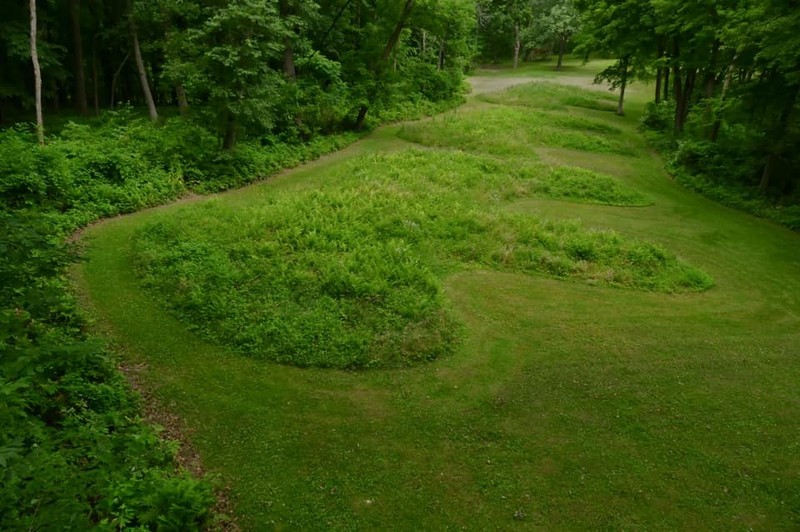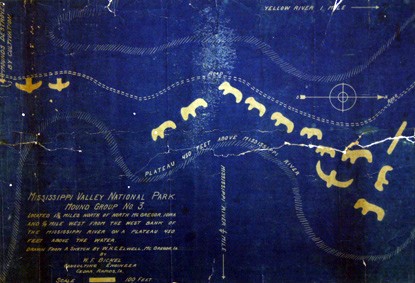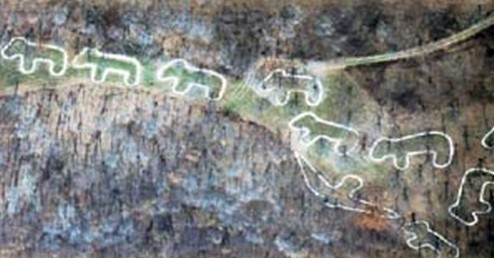Effigy Mounds National Monument
Introduction
Text-to-speech Audio
Effigy Mounds National Monument, located in Harpers Ferry, Iowa, preserves more than 200 Late Woodland Period (300-1100 CE) mounds, including 31 effigy mounds in the shapes of birds and bears. The largest is the Great Bear Mound, which is 70 feet wide (from the shoulder to the bottom of the legs), 137 feet long, and 3.5 feet high. The site also includes a visitor center with exhibits displaying artifacts and natural specimens, and 14 miles of hiking trails (see below). Effigy Mounds National Monument was established in 1949 and was listed on the National Register of Historic Places in 1966.
Images




Backstory and Context
Text-to-speech Audio
Woodland Culture
The Woodland Indian Culture consists of three sub-cultures: the Early Woodland, the Middle Woodland, and the Late Woodland (Effigy). Effigy Mound-builders created mounds of earth for ceremonial, religious, or burial purposes in conical (round) and linear styles, as well as, in the shapes of bear, birds, deer, bison, lynx, panthers, turtles, or water spirits. Water spirit mounds, including turtle and panther, are traditionally found near Lake Winnebago and Lake Michigan. Bear and bird mound shapes are the most prevalent along the Mississippi River in southwest Wisconsin and northeast Iowa.
Effigy Monument Mounds
The Monument contains four types of mounds and four variations of burial styles used during the Woodland period. The first type of mound, the conical, is a round and domed earthen compound used for burials. Linear mounds, the second style, are ceremonial, and can often be found connected to conical mounds to form a third style, compound mounds, which were used for burials. Although conical mounds are found throughout Woodland regions, linear and compound mounds are exclusive to the Effigy Mounds area. The fourth type of mounds, effigy mounds, were used predominately for ceremonial purposes.
Trails
Visitors to the Effigy Mounds National Monument can explore the mounds through fourteen miles of hiking trails. The Yellow River Bridge Trail, a two mile round-trip hike, traverses a wetland environment that contains many resources, including vegetation and animals, used during the Woodland period. Hikers can see more than twenty mounds representing all four styles along Fire Point Trail, another two mile round-trip walk. Within a two mile hike around the Visitor Center, hikers can view the Great Bear Mound, one of the largest effigies of the Monument, at 137 feet long and 70 feet wide.
Tribal Affiliation
Besides continual visitor patronage, Effigy Mounds National Monument is also affiliated with twelve present-day American Indian Tribes. These include: Iowa Tribe of Kansas and Nebraska, Iowa Tribe of Oklahoma, Otoe-Missouria Tribe of Oklahoma, Ho-Chunk Nation of Wisconsin, Winnebago Tribe of Nebraska, Upper Sioux Community of Minnesota, Shakopee Mdewakanton Sioux Community in the State of Minnesota, Lower Sioux Indian Community in the State of Minnesota, Prairie Island Indian Community in the State of Minnesota, Sac and Fox Tribe of the Mississippi in Iowa, Sac and Fox Nation of Missouri in Kansas and Nebraska, and Sac and Fox Nation of Oklahoma.
Cite This Entry
Gehringer, Jennifer and Ben M.. "Effigy Mounds National Monument." Clio: Your Guide to History. October 16, 2021. Accessed April 2, 2025. https://theclio.com/tour/432/40/reverse
Sources
"Effigy Moundbuilders." National Park Service. Last Updated May 17, 2021. https://home.nps.gov/efmo/learn/historyculture/effigy-moundbuilders.htm.
Jacobsen, James. "Effigy Mounds National Monument." National Park Service - National Register of Historic Places Nomination Form. October 15, 1966. https://npgallery.nps.gov/GetAsset/5e7630ab-f5b2-49d9-bd5c-2d0f1e3f3602.
Mound image via Effigy Mounds National Monument

